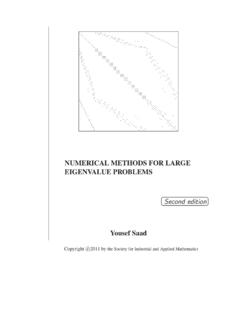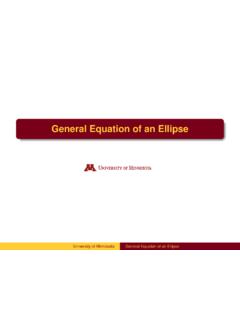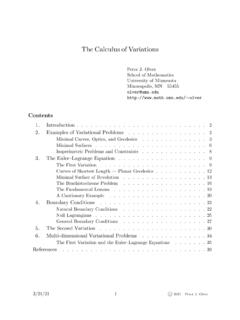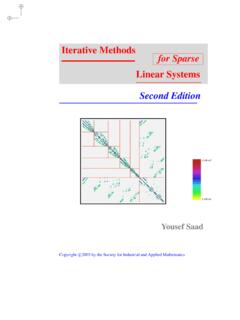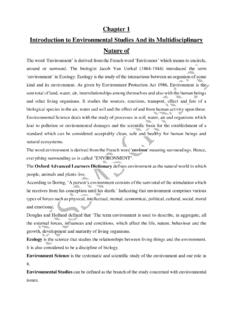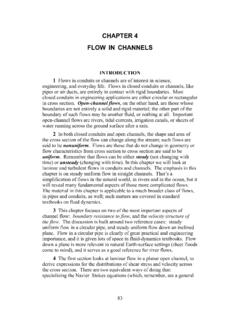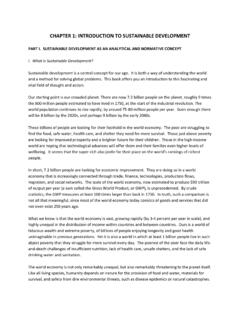Transcription of Association Analysis: Basic Concepts and Algorithms
1 6 Association Analysis: Basic Concepts andAlgorithmsMany business enterprises accumulate large quantities of data from their day-to-day operations. For example, huge amounts of customer purchase data arecollected daily at the checkout counters of grocery stores. Table illustratesan example of such data, commonly known asmarket basket row in this table corresponds to a transaction, which contains a uniqueidentifier labeledTIDand a set of items bought by a given customer. Retail-ers are interested in analyzing the data to learn about the purchasing behaviorof their customers. Such valuable information can be used to support a vari-ety of business-related applications such as marketing promotions, inventorymanagement, and customer relationship chapter presents a methodology known asassociation analysis,which is useful for discovering interesting relationships hidden in large datasets.
2 The uncovered relationships can be represented in the form ofassocia-Table example of market basket {Bread, Milk}2{Bread, Diapers, Beer, Eggs}3{Milk, Diapers, Beer, Cola}4{Bread, Milk, Diapers, Beer}5{Bread, Milk, Diapers, Cola}328 Chapter 6 Association Analysistion rulesor sets of frequent items. For example, the following rule can beextracted from the data set shown in Table :{Diapers} {Beer}.The rule suggests that a strong relationship exists between the sale of diapersand beer because many customers who buy diapers also buy beer. Retailerscan use this type of rules to help them identify new opportunities for cross-selling their products to the market basket data, Association analysis is also applicable to otherapplication domains such as bioinformatics, medical diagnosis, Web mining,and scientific data analysis. In the analysis of earth science data, for example,the Association patterns may reveal interesting connections among the ocean,land, and atmospheric processes.
3 Such information may help earth scientistsdevelop a better understanding of how the different elements of the Earthsystem interact with each other. Even though the techniques presented hereare generally applicable to a wider variety of data sets, for illustrative purposes,our discussion will focus mainly on market basket are two key issues that need to be addressed when applying associ-ation analysis to market basket data. First, discovering patterns from a largetransaction data set can be computationally expensive. Second, some of thediscovered patterns are potentially spurious because they may happen simplyby chance. The remainder of this chapter is organized around these two is-sues. The first part of the chapter is devoted to explaining the Basic conceptsof Association analysis and the Algorithms used to efficiently mine such pat-terns. The second part of the chapter deals with the issue of evaluating thediscovered patterns in order to prevent the generation of spurious Problem DefinitionThis section reviews the Basic terminology used in Association analysis andpresents a formal description of the RepresentationMarket basket data can be represented in a binaryformat as shown in Table , where each row corresponds to a transactionand each column corresponds to an item.
4 An item can be treated as a binaryvariable whose value is one if the item is present in a transaction and zerootherwise. Because the presence of an item in a transaction is often consideredmore important than its absence, an item is anasymmetricbinary Definition329 Table binary0/1representation of market basket representation is perhaps a very simplistic view of real market basket databecause it ignores certain important aspects of the data such as the quantityof items sold or the price paid to purchase them. Methods for handling suchnon-binary data will be explained in Chapter and Support CountLetI={i1,i2,..,id}be the set of all itemsin a market basket data andT={t1,t2,..,tN}be the set of all transactionticontains a subset of items chosen fromI. In associationanalysis, a collection of zero or more items is termed an itemset. If an itemsetcontainskitems, it is called ak-itemset.
5 For instance,{Beer,Diapers,Milk}is an example of a 3-itemset. The null (or empty) set is an itemset that doesnot contain any transaction width is defined as the number of items present in a trans-action. A transactiontjis said to contain an itemsetXifXis a subset oftj. For example, the second transaction shown in Table contains the item-set{Bread,Diapers}but not{Bread,Milk}. An important property of anitemset is its support count, which refers to the number of transactions thatcontain a particular itemset. Mathematically, the support count, (X), for anitemsetXcan be stated as follows: (X)= {ti|X ti,ti T} ,where the symbol| |denote the number of elements in a set. In the data setshown in Table , the support count for{Beer,Diapers,Milk}is equal totwo because there are only two transactions that contain all three RuleAn Association rule is an implication expression of theformX Y, whereXandYare disjoint itemsets, ,X Y=.
6 Thestrength of an Association rule can be measured in terms of itssupportandconfidence. Support determines how often a rule is applicable to a given330 Chapter 6 Association Analysisdata set, while confidence determines how frequently items inYappear intransactions that containX. The formal definitions of these metrics areSupport,s(X Y)= (X Y)N;( )Confidence,c(X Y)= (X Y) (X).( )Example the rule{Milk,Diapers} {Beer}. Since thesupport count for{Milk,Diapers,Beer}is 2 and the total number of trans-actions is 5, the rule s support is 2/5= The rule s confidence is obtainedby dividing the support count for{Milk,Diapers,Beer}by the support countfor{Milk,Diapers}. Since there are 3 transactions that contain milk and di-apers, the confidence for this rule is 2/3= Use Support and Confidence?Support is an important measurebecause a rule that has very low support may occur simply by chance.
7 Alow support rule is also likely to be uninteresting from a business perspectivebecause it may not be profitable to promote items that customers seldom buytogether (with the exception of the situation described in Section ). Forthese reasons, support is often used to eliminate uninteresting rules. As willbe shown in Section , support also has a desirable property that can beexploited for the efficient discovery of Association , on the other hand, measures the reliability of the inferencemade by a rule. For a given ruleX Y, the higher the confidence, the morelikely it is forYto be present in transactions that containX. Confidence alsoprovides an estimate of the conditional probability analysis results should be interpreted with caution. The infer-ence made by an Association rule does not necessarily imply causality. Instead,it suggests a strong co-occurrence relationship between items in the antecedentand consequent of the rule.
8 Causality, on the other hand, requires knowledgeabout the causal and effect attributes in the data and typically involves rela-tionships occurring over time ( , ozone depletion leads to global warming).Formulation of Association Rule Mining ProblemThe associationrule mining problem can be formally stated as follows:Definition ( Association Rule Discovery).Given a set of transactionsT, find all the rules having support minsupand confidence minconf,whereminsupandminconfare the corresponding support and Definition331A brute-force approach for mining Association rules is to compute the sup-port and confidence for every possible rule. This approach is prohibitivelyexpensive because there are exponentially many rules that can be extractedfrom a data set. More specifically, the total number of possible rules extractedfrom a data set that containsditems isR=3d 2d+1+1.( )The proof for this equation is left as an exercise to the readers (see Exercise 5on page 405).
9 Even for the small data set shown in Table , this approachrequires us to compute the support and confidence for 36 27+ 1 = 602 than 80% of the rules are discarded after applyingminsup= 20% andminconf= 50%, thus making most of the computations become wasted. Toavoid performing needless computations, it would be useful to prune the rulesearly without having to compute their support and confidence initial step toward improving the performance of Association rule min-ing Algorithms is to decouple the support and confidence requirements. FromEquation , notice that the support of a ruleX Ydepends only onthe support of its corresponding itemset,X Y. For example, the followingrules have identical support because they involve items from the same itemset,{Beer,Diapers,Milk}:{Beer,Diaper s} {Milk},{Beer,Milk} {Diapers},{Diapers,Milk} {Beer},{Beer} {Diapers,Milk},{Milk} {Beer,Diapers},{Diapers} {Beer,Milk}.
10 If the itemset is infrequent, then all six candidate rules can be pruned imme-diately without our having to compute their confidence , a common strategy adopted by many Association rule miningalgorithms is to decompose the problem into two major Itemset Generation, whose objective is to find all the item-sets that satisfy theminsupthreshold. These itemsets are called Generation, whose objective is to extract all the high-confidencerules from the frequent itemsets found in the previous step. These rulesare called strong computational requirements for frequent itemset generation are gen-erally more expensive than those of rule generation. Efficient techniques forgenerating frequent itemsets and Association rules are discussed in Sections , Chapter 6 Association Analysisnullbacdedecebeaeadacababcabdabe abcdacdabcdeabceabdeacdebcdeaceadebcdbce bdecdebdbccdFigure itemset Frequent Itemset GenerationA lattice structure can be used to enumerate the list of all possible shows an itemset lattice forI={a, b, c, d, e}.


